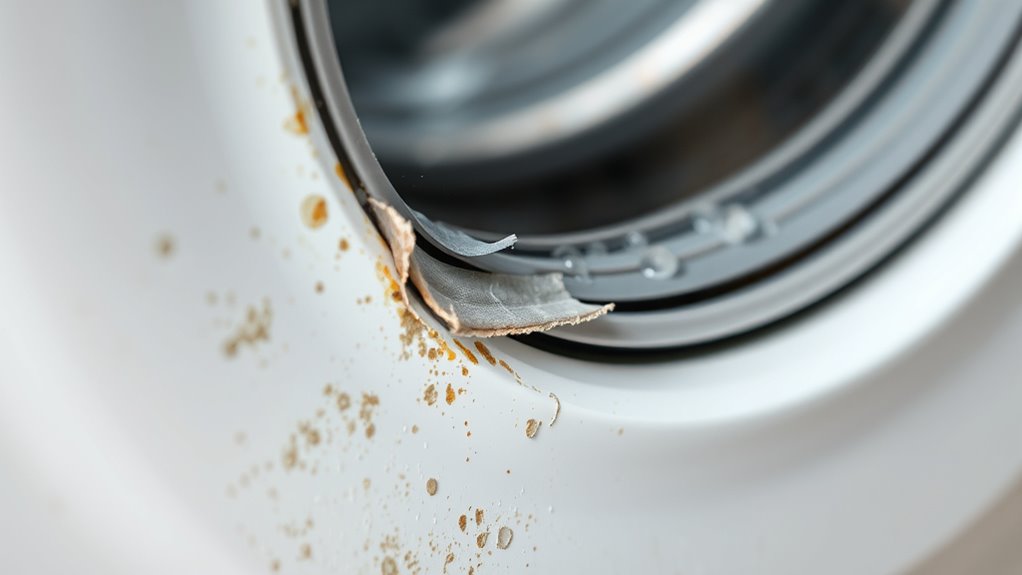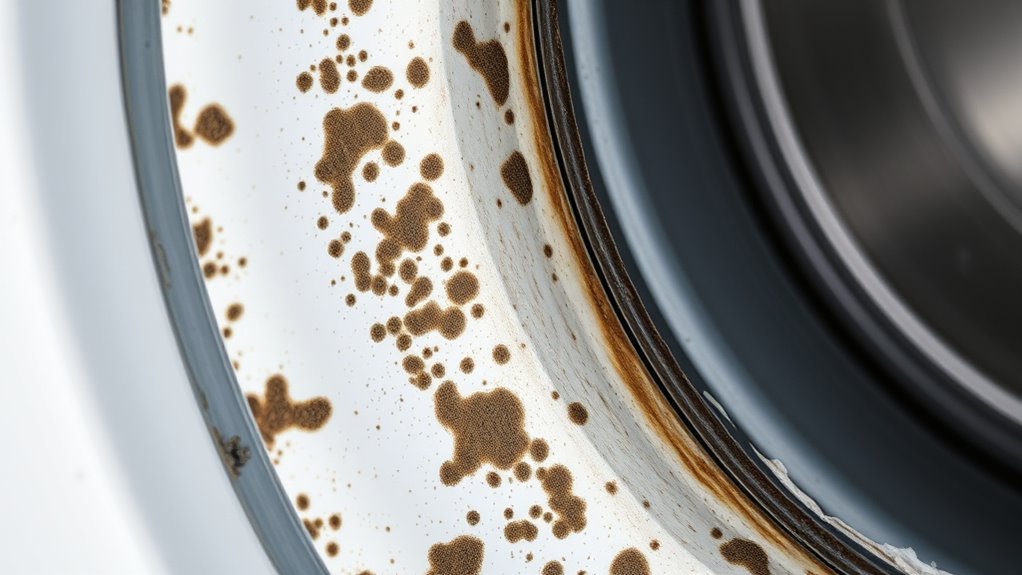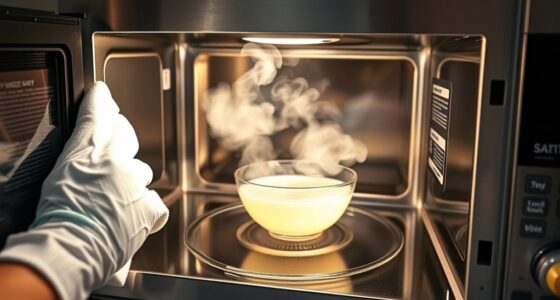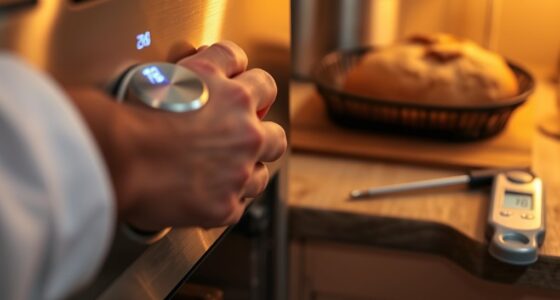You should replace your appliance gaskets and seals as soon as you notice leaks, cracks, or signs of deterioration like brittleness or warping. Persistent leaks or difficulty maintaining a proper seal mean it’s time for a replacement. Regular inspections can help catch problems early before they lead to costly repairs. If you keep an eye out for these signs, you’ll maintain your appliance’s efficiency and extend its lifespan—keep going to learn more about how to do it right.
Key Takeaways
- Replace gaskets or seals when visible cracks, tears, or warping are present.
- If leaks persist despite cleaning and tightening, it indicates a need for replacement.
- Deterioration from age, heat, or moisture suggests proactive replacement to prevent failures.
- Follow manufacturer guidelines to ensure proper fit and installation during replacement.
- Regular inspections help identify early signs of wear, enabling timely maintenance and preventing costly repairs.

If your appliances are leaking or not sealing properly, replacing worn or damaged gaskets and seals can restore their efficiency and prevent further issues. Recognizing when to replace these components is vital to maintaining peak performance and avoiding costly repairs down the line. To do so effectively, you need to follow some straightforward maintenance tips and troubleshooting steps.
Start by inspecting the gasket or seal for visible signs of damage, such as cracks, tears, or warping. Sometimes, a simple visual check can reveal whether the component has become brittle or deformed over time. If you notice any of these issues, it’s a clear sign that replacement is necessary. Additionally, check for leaks around the appliance, which often indicate a compromised seal. A leak that persists even after cleaning or tightening fittings suggests the gasket or seal no longer seals properly and needs replacing.
In the troubleshooting steps, contemplate whether the appliance is functioning efficiently. For example, if your refrigerator is running constantly or your dishwasher isn’t draining properly, worn seals might be the culprit. These symptoms can also be caused by dirt or debris trapped in the seal, so cleaning the gasket thoroughly should be your first step. If cleaning doesn’t resolve the issue, then replacing the gasket or seal is the next move. Maintaining your appliances with regular inspections can prevent problems from escalating, saving you time and money.
Another tip is to keep an eye on the age of your gaskets and seals. Most rubber or silicone components deteriorate over time, especially when exposed to heat, moisture, or chemicals. If your appliance is several years old, it’s wise to contemplate replacement even if you haven’t noticed obvious leaks yet. Sometimes, a proactive approach can extend the lifespan of your appliance and prevent emergency repairs. Being aware of exponential deterioration can help you anticipate when replacement might be necessary before issues become severe.
When replacing gaskets and seals, always use the correct part specified by the manufacturer. Using an incompatible gasket can result in poor sealing, leaks, or even damage to the appliance. Follow the manufacturer’s instructions carefully, and if you’re unsure, consult a professional or refer to the appliance’s manual. Proper installation is vital to ensure an effective seal and restore the appliance’s efficiency.
Frequently Asked Questions
Can I Replace Gaskets Myself or Need a Professional?
You can definitely handle a DIY repair if you’re comfortable with basic tools and follow instructions carefully. Replacing gaskets and seals is often straightforward and saves you money. However, if the task seems complex or involves disassembling major parts, it’s better to call a professional service. They have the expertise to make certain the job is done correctly, avoiding leaks or damage. Trust your skill level before deciding on DIY or professional help.
How Long Do Appliance Gaskets Typically Last?
You can expect appliance gaskets to last around 3 to 5 years, but it depends on gasket material and usage. Rubber gaskets typically have a shorter lifespan, around 3 years, while silicone ones can last up to 5 years or more. Regularly inspect for cracks, leaks, or stiffness, and consider a lifespan estimation based on your specific gasket material to determine when replacement is needed.
Are There Specific Cleaning Tips for Extending Gasket Life?
To extend gasket life, you should follow proper cleaning techniques and gasket maintenance. Regularly wipe gaskets with a damp cloth and mild soap to remove dirt and residue. Avoid harsh chemicals and abrasive scrubbers that can damage the seal. Keep gaskets dry and check for cracks or deformities. Proper cleaning and maintenance help maintain a tight seal, prevent leaks, and prolong the gasket’s lifespan.
What Are Signs of Gasket Mold or Mildew Buildup?
You’ll notice mold growth or mildew buildup on your appliance gasket if it looks fuzzy, damp, or discolored, often gray, green, or black. A musty smell is also a clear sign. These issues typically develop in humid environments or if you neglect regular cleaning. If you spot these signs, clean the gasket thoroughly and dry it completely to prevent further mold or mildew buildup, protecting your appliance’s longevity.
Do Warranties Cover Gasket Replacements?
Warranties often act like safety nets, but they don’t always catch gasket replacements. You need to check your warranty policies carefully, as coverage varies. Some warranties include replacement coverage for gaskets if they fail due to manufacturing defects, but others don’t. Don’t assume; contact your appliance manufacturer or review your warranty documents to understand what’s covered. Knowing this helps you avoid unexpected costs and keeps your appliances running smoothly.
Conclusion
Knowing when to replace your appliance gaskets and seals is like tending a garden—you need to catch the signs early before leaks and damage take root. Regular inspections, noticing cracks, or diminished sealing performance are your clues. Don’t wait for a flood to remind you; instead, stay proactive. By replacing these parts at the right time, you keep your appliances running smoothly, preventing costly repairs and turning your home into a fortress of leak-free comfort.










